| The Sun |
| The Sun |
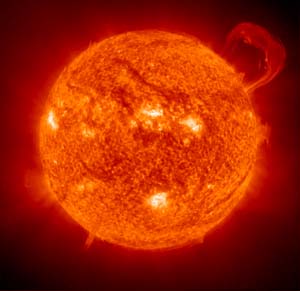
The Sun seen through ultraviolet rays. Picture from: SOHO -ESA- NASA |
The Sun Our solar system's star, the Sun, has inspired mythological stories in cultures around the world, including those of the ancient Egyptians, the Aztecs of Mexico, Native American tribes of North America and Canada, the Chinese, and many others. A number of ancient cultures built stone structures or modified natural rock formations to observe the Sun and Moon, they charted the seasons, created calendars, and monitored solar and lunar eclipses. These architectural sites show evidence of deliberate alignments to astronomical phenomena: sunrises, moonrises, moonsets, even stars or planets. The Sun is the closest star to Earth, at a mean distance from our planet of 149.60 million kilometers (92.96 million miles). This distance is known as an astronomical unit (abbreviated AU), and sets the scale for measuring distances all across the solar system. The Sun, a huge sphere of mostly ionized gas, supports life on Earth. It powers photosynthesis in green plants, and is ultimately the source of all food and fossil fuel. The connection and interactions between the Sun and Earth drive the seasons, ocean currents, weather, and climate. The Sun is 332,900 times more massive than Earth and contains 99.86 percent of the mass of the entire solar system. It is held together by gravitational attraction, producing immense pressure and temperature at its core. The Sun has six regions - the core, the radiative zone, and the convective zone in the interior; the visible surface, known as the photosphere; the chromosphere; and the outermost region, the corona.
|
|||||||||||||||||||||||||||
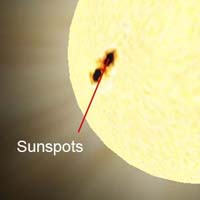 |
At the core, the temperature is about 15 million degrees Celsius (about 27 million degrees Fahrenheit), which is sufficient to sustain thermonuclear fusion. The energy produced in the core powers the Sun and produces essentially all the heat and light we receive on Earth. Energy from the core bounces around the radiative zone, taking about 170,000 years to get to the convective zone. The temperature drops below 2 million degrees Celsius (3.5 million degrees Fahrenheit) in the convective zone, where large bubbles of hot plasma (a soup of ionized atoms) move upwards. | |||||||||||||||||||||||||||
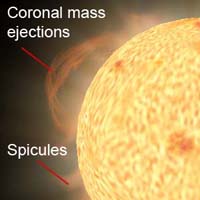 |
The Sun's "surface" - the photosphere - is a 500-kilometer-thick (300-mile-thick) region, from which most of the Sun's radiation escapes outward and is detected as the sunlight we observe here on Earth about eight minutes after it leaves the Sun. Sunspots in the photosphere are areas with strong magnetic fields that are cooler, and thus darker, than the surrounding region. The temperature of the photosphere is about 5,500 degrees Celsius (10,000 degrees Fahrenheit). Above the photosphere lie the tenuous chromosphere and the corona. Visible light from these top regions is usually too weak to be seen against the brighter photosphere, but during total solar eclipses, when the Moon covers the photosphere, the chromosphere can be seen as a red rim around the Sun and the corona forms a beautiful white halo. | |||||||||||||||||||||||||||
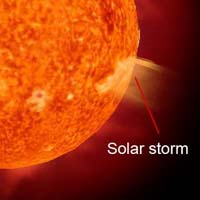 |
||||||||||||||||||||||||||||
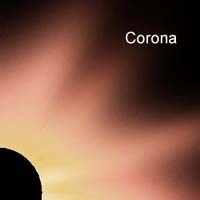 |
Above the photosphere, the temperature increases with altitude, reaching temperatures as high as 2 million degrees Celsius (3.5 million degrees Fahrenheit). The source of coronal heating has been a scientific mystery for more than 50 years. Likely solutions have emerged from observations by the Solar and Heliospheric Observatory (SOHO) and the Transition Region and Coronal Explorer (TRACE) missions, which found patches of magnetic field covering the entire solar surface. Scientists now think that this magnetic "carpet" is probably a source of the corona's intense heat. The corona cools rapidly, losing heat as radiation and in the form of the solar wind, a stream of charged particles that flows to the edge of the solar system. | |||||||||||||||||||||||||||
The 4 illustrations were made with SISV 3D-models |
Solar Eclipse on 29 March 2006 A merger of a space image from the ESA/NASA SOHO spacecraft and an image taken from Kastellorizo, Greece, by the Williams College Eclipse Expedition (from Williamstown, Massachusetts). Though SOHO can observe the solar corona on the face of the Sun and can observe the outer part of the solar corona, the "doughnut" between those images is not visible from Earth except during total solar eclipses. The Williams expedition is supported by grants from NSF, NASA, and National Geographic. The central image from SOHO shows the Sun's disk at temperatures around 60,000 - 80,000 K. The outer image from SOHO shows gas at the millions of degrees typical of the sun's corona. Merging the eclipse image with the space image from SOHO allows astronomers to trace features in the corona from their bases on the Sun's surface up until the gas escapes into interplanetary space; some of this gas winds up hitting our Earth's upper atmosphere. Credits: Williams College Eclipse Expedition (Jay Pasachoff, Bryce Babcock, Steven Souza, Jesse Levitt, Megan Bruck, Shelby Kimmel, Paul Hess, Anna Tsykalova, Amy Steele), with support from NSF / NASA / National Geographic.
|
|||||||||||||||||||||||||||
Information from: SSE-JPL-NASA |
||||||||||||||||||||||||||||